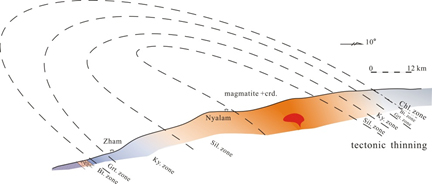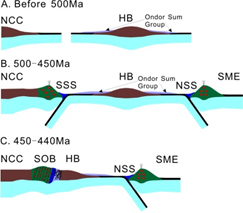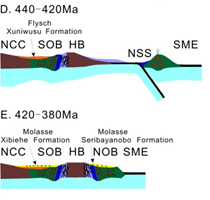Ogenic dynamics (Jingjiang Zhang et al.)
Orogenies are the most important geological processes on the earth that form huge orogens, and such processes can be classified into two categories: collisional orogenies and accretionary orogenies, which are represented by the Himalayan Orogen and the Central Asian Orogenic Belt (CAOB) respectively.
As for the typical collisional orogeny of the Himalayas, we carried out the studies on: the initial India-Asia collision, orogenic process and their remote effects in Asian continent. Firstly, we place an accurate temporal constraint on the initial collision, using paleomagnetism and isotopic chronology. The paleomagnetic and chronological data from Lhasa and Himalayan blocks determine that the initial collision occurred at the Cretaceous/Tertiary boundary, and eliminate the possibility for the collision later than 50 Ma.
Secondly, we present an accurate depict and propose a new model for the Himalayan orogeny, based on the studies of deformational and thermal histories of the orogen. The proposed model is as the following: the India-Asia collision caused the crustal thickening, which resulted in the progressive metamorphism and formed the Barrovian metamorphic belt in the orogen; partial melting (anatexis) happened to the thickened crust since about 42 Ma; the partially molten mid and lower crust began to extrude laterally along the Himalayan topographic front, driven by the buoyance and gravity gradient, in a mode similar to a channel-flow, which formed the over-turned antiform of the Barrovian metamorphic belt (Fig.1); such a relaxation of the Himalayan orogen stopped and a new thickening orogeny started since about 13 Ma. In a word, the Himalayan orogeny is a classical orogeny (collision => thickening => progressive metamorphism + anatexis => relaxation + exhumation) followed by a new (intra-continental?) orogeny (still ongoing now); and the flow of the partially molten crust play a key role in the orogenic process.

Fig. 1. The overturned antiform of the Barrovian metamorphic belt across the Himalayan orogen.
Besides the Himalayan Orogeny, the India-Asia collision also caused the extensive and intensive deformation within the Asian continent, i.e., the remote effects of the collision. The Cenozoic deformation of the Tianshan is a typical example of such effect and our systematic paleomagnetic researches show that the Cenozoic uplift of the Tianshan started since about 20 Ma, followed by multiple stages of rapid uplift at about 16 Ma, about 12-11 Ma and about 7-5 Ma. We also proof a difference of 1 Ma in the basal ages of the Xiyu conglomerates between the two sides of Tianshan due to differential uplift.
Another form of the remote effect is the large number of large-scale ductile shear zones in Tibet and its eastern margin. These shear zones responded and constrained the successive oblique convergence, and recorded the rheological processes of the continental tectonics. The synthetical studies of geological mapping, structural, strain and fabric analyses, and isotopic chronology demonstrate that the large-scale ductile shear zones in western Yunnan are not resulted only by the lateral-slip shear, but formed by antiformal doming of the mid-lower crustal decollement zones and superposed by the lateral-slip shear in mid-shallow crustal level.
As for the CAOB, we made great scientific contributions to the Paleozoic tectonics of Tianshan-Juggar region and Xing’an-Mongolia orogen. In Tianshan-Juggar region, we propose: 1) the continental crust can grow during both subduction and post-collision periods, and the crustal growth is characterized by vertical growth in post-collision, obviously different from the lateral growth during subduction; 2) the oceanic subduction in northern Xinjiang started since the Early Cambrian, and collage of the blocks happened no later than the Late Carboniferous. In Xing’an-Mongolia orogen, we proposed a new model of bidirectional subduction and collisional orogeny during early-middle Paleozoic (Fig. 2), and constructed the tectonic section of the Xing’an-Mongolia orogen in Sunite zuoqi area.
These scientific achievements contribute greatly to better understanding of the Paleo-Asian Ocean and CAOB, enhance enormously the international influence of Chinese geologists and promote the studies in the related fields.


Fig. 2. A new model of bidirectional subduction and collisional orogeny during early-middle Paleozoic for Xing’an-Mongolia orogen.